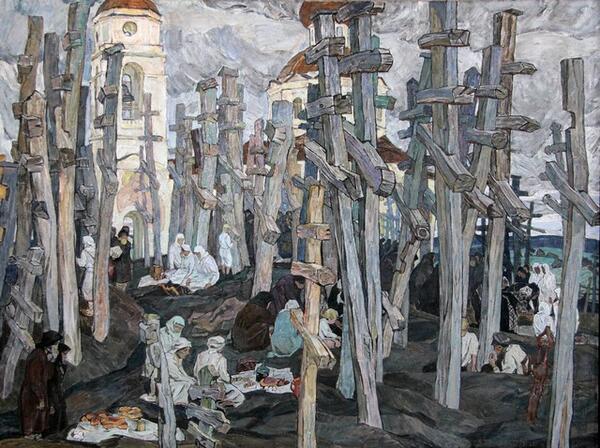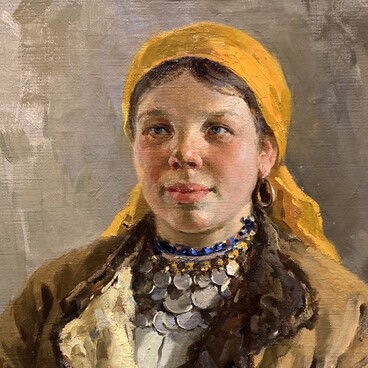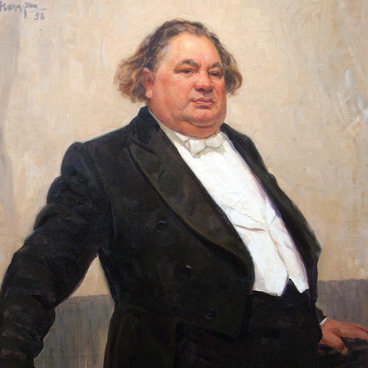In the 1960s, many Mordovian artists created socially significant monumental canvases, addressed the themes of man and humanity, historical past and present. In the 1970s, the mood of the canvases began to change: the civic pathos was muted by philosophical reflections. At the turn of the 1970s, such an allegorical picture titled “From the Past. Memory Day” was painted by the Honored Artist of the Russian Federation Viktor Andreevich Bednov (1938–2013). In 1957, he graduated from the Konstantin Savitsky Art School in Penza. Over the years, he headed the Mordovian branch of the Artists’ Union of the USSR.
It took the artist four years — from 1967 to 1971 — to create this large-scale canvas measuring over two meters in height. Viktor Bednov was inspired by his creative trip to the Tengushevsky district of Mordovia. At a rural cemetery, the artist saw an unusual picture: very tall crosses towered over the graves, they were taller than an average man’s height.
According to old local beliefs, the height of the crosses corresponded to the size of good deeds. The more respect a person earned during their lifetime, the higher the cross placed on their grave was. It was a visible sign of honoring their good memory, which remained after their death and served as a link in the chain of generations.
Impressions from the trip coincided with the artist’s strive for a philosophical understanding of life. The image of tall crosses standing close together occupies the entire surface of the canvas. At their foot on the ground there are several groups of women, mostly in national white costumes. They laid out ritual food on the tablecloths right on the graves to honor the memory of their deceased relatives. Behind the dense forest of crosses, we can see a belfry and a church.
The finished canvas did not immediately find its way to the public: the painting was not accepted for exhibitions. Only in the 1990s the canvas was included in the permanent exhibition of the Mordovian Museum of Visual Arts named after Stepan Dmitrievich Erzia in Saransk. Although the painting evokes thoughts about death, it is not tragic: light colors create a mood of poignant sadness and kind memory of the departed.
It took the artist four years — from 1967 to 1971 — to create this large-scale canvas measuring over two meters in height. Viktor Bednov was inspired by his creative trip to the Tengushevsky district of Mordovia. At a rural cemetery, the artist saw an unusual picture: very tall crosses towered over the graves, they were taller than an average man’s height.
According to old local beliefs, the height of the crosses corresponded to the size of good deeds. The more respect a person earned during their lifetime, the higher the cross placed on their grave was. It was a visible sign of honoring their good memory, which remained after their death and served as a link in the chain of generations.
Impressions from the trip coincided with the artist’s strive for a philosophical understanding of life. The image of tall crosses standing close together occupies the entire surface of the canvas. At their foot on the ground there are several groups of women, mostly in national white costumes. They laid out ritual food on the tablecloths right on the graves to honor the memory of their deceased relatives. Behind the dense forest of crosses, we can see a belfry and a church.
The finished canvas did not immediately find its way to the public: the painting was not accepted for exhibitions. Only in the 1990s the canvas was included in the permanent exhibition of the Mordovian Museum of Visual Arts named after Stepan Dmitrievich Erzia in Saransk. Although the painting evokes thoughts about death, it is not tragic: light colors create a mood of poignant sadness and kind memory of the departed.






